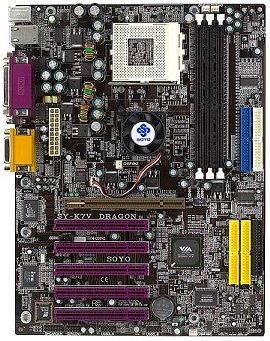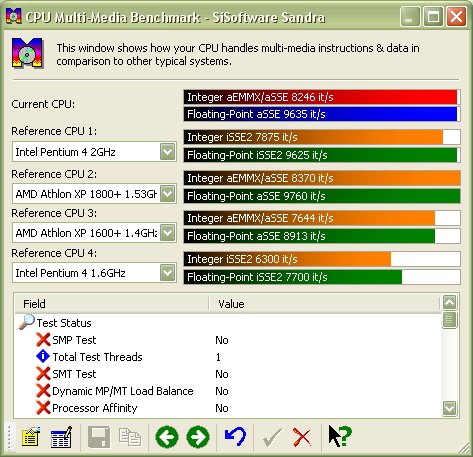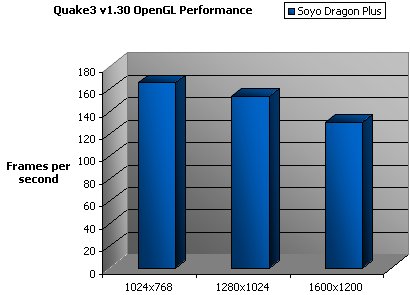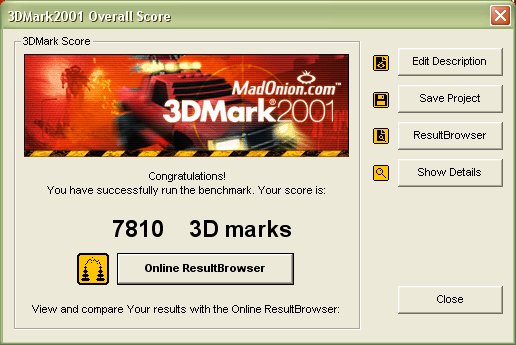|
 
Introduction
It's been a little while since we last looked at the original SY-K7V Dragon from Soyo that sported a whole host of feature allied to VIA's DDR chipset, the KT266. The board sported on board RAID, 100Mbit/sec Ethernet and audio (using the excellent CMI8738 C-Media chipset) and also support for a smart card reader and the now infamous PCB and slot colouring. The black PCB and purple coloured PCI slots certainly made the board stand out and despite the comparatively poor performance and a now resolved USB issue the board was excellent.
So is the Dragon Plus more of the same? Taking full advantage of VIA's VMAP technology, the Plus is identical to the original board with the new KT266A northbridge dropped right in. A new BIOS should then be pretty much all that's needed to get the board working since the VMAP chips are pin compatible with their predecessors leaving only minor signalling issues and other low level traits to clean up before releasing the new product.
This lets manufacturers bring out updated versions of products in the shortest amount of time possible, decreasing time to market and letting a board maker get maximum sales.
Before we continue, if you've noticed the title of this article you'll be wondering why we haven't done a full review of the board. At the time I ran the numbers on the board, the test processor was an underwhelming XP1800+ that didn't seem to take too well to being overclocked in the Dragon Plus. I'm pretty confident that the board could go higher than I managed to take it with that processor, so just know we're focussing on out of the box performance. We've managed to source a rather special XP1500, fully unlocked, that performs excellently at a massive range of speeds. It's from the same batch as my original XP1500 which has now gone to a new home.
When the new processor arrives we'll revisit the board with an update and bring you the overclocked numbers. We're eager to show you the board however so we took the decision to put out a first look and revisit the board in the future with a better processor.
If you'd like a refresher on the original board features that are carried over to the Plus take a look here. We covered the unique features of the board in some detail and everything applies here too. The boards are identical with the exception of the northbridges so we'll concentrate more on performance here. Everything we mentioned with regards to presentation, the bundle and the layout can be carried across to this board so please take a look at the original review to refresh your memory.
Before we take a look at the performance we'll take a look at the technical specification of the board.
Technical Specification
CPU Support
Supports 200/266MHz Front Side Bus DDR trasfer on all release Athlon(4/MP/XP) and Duron processors and possible future processors.
CPU Settings
100-132MHz for 100Mhz CPU
133-233MHz for 133Mhz CPU
All multipliers from 6.0x to 14.0x
Memory
3 x DDR memory slots supporting 1.5GB total memory (PC1600/PC2100)
Expandability
1 x AGP Pro slot
5 x 32-bit bus master PCI slots
2 x UDMA33/66/100 ports for 4 devices
6 x USB 1.1 ports
IDE RAID
Promise ATA100 RAID0/1 controller that also functions as a normal IDE controller supporting 4 devices
Hardware Audio
C-Media CMI8738 supporting 4/5/5.1 function and SPDIF output for digital audio input and output
Ethernet
Supports 10/100Mbit per second Ethernet via the VIA southbridge
Smart Card Reader
PC/SC (Personal Computer Smart Card) compliant smart card reader (supplied) and supporting chipset. Supports Smart Card power on.
As we can see, the Dragon Plus is replete with features and also sports 5-PCI slots despite the packed PCB meaning you get one of the most feature filled motherboards on the market with VIA's flagship KT266A DDR chipset. The onboard features make finding something to put in the PCI slots something of a challenge.
 
Stock Performance (11.5 x 133, 1533Mhz)
As we noted in the original review, the KT266 had issues with the USB controller on the southbridge in that the BIOS shuts off the controller at front side bus speeds over 138Mhz. The KT266A boards dont suffer from that trait and all on board functions are available at all front side bus speeds.
The extra performance in the KT266A chipset comes from tweaks to the memory controller that offer greater throughput and bandwidth. As we noted in our recent KR7A-RAID review VIA are cagey about the improvements to the memory controller and I rely on an article on Anandtech for the reasons behind it which Anand speculates to be focussed on internal memory buffers within the Northbridge.
So the extra performance comes from increased memory bandwidth when comparing it to the previous Dragon board and other KT266 solutions from other manufacturers. We'll see how the extra memory bandwidth helps overall system performance using our standard benchmarks. First off, the test system as always.
Test System
- Soyo SY-K7V Dragon Plus Motherboard
- AMD XP1800 Processor (1533Mhz)
- 256Mb Crucial PC2100 DDR CAS2.5 module @ CAS2
- Gainward Ti550 GeForce3 Ti500 (240/500)
- Adaptec 39160 PCI SCSI Dual Channel U160 controller
- 2 x 73Gb Seagate Cheetah 73LW U160 10,000rpm SCSI disks
- Plextor 12/10/32S SCSI CDRW
- Windows XP Professional Build 2600.xpclient.010817-1148
- DetonatorXP 22.40 NVIDIA drivers
- Aquamark v2.3
- Quake3 v1.30
- POVRay v3.1g.msvc.unofficial-win32 dated 28 August 2001
- 3DMark 2001 Professional
- SiSoftware Sandra v2002.1.8.59
As usual the operating system was freshly installed on the board and the test software installed along with any drivers needed. In the case of all tests, each one is performed 3 times and the top and bottom results discarded leaving the middle result as the one we display.
As always, to verify correct processor and memory controller operation we use SiSoftware Sandra which utilises a pair of CPU tests and a memory bandwidth test to gauge system performance and it's those we look at first.
CPU Arithmetic Benchmark

CPU Multimedia Benchmark

Memory Bandwidth Benchmark

As usual the CPU results are fairly uninteresting and just show us that the processor is working well in the test system. The results are exactly where they should be in relation to the Sandra reference results and if you look closely you'll see that we include the XP1800 processor in the reference results and that the result matches up with proper accuracy.
The memory bandwidth benchmark is more interesting however. We can see first hand that the Dragon has even managed to slightly improve on the reference KT266A numbers provided by Sandra and encroach on the Intel i845D performance numbers. The results are still some way off the memory bandwidth figures provided by Intel i850 and RAMBUS memory technology but the low latency of DDR makes the gap a lot smaller in the real world.
The increased performance over the stock KT266A numbers that Sandra provides can be attributed to more aggressive timings in the memory controller than normally would be specified by VIA for the KT266A Northbridge. The Soyo performs impressively well here and matches the KR7A-RAID out of the box in terms of memory bandwidth as indicated by Sandra.
Our next test used to confirm CPU performance is POVRay. It's a redundant test but confirms that the CPU is performing properly and it's very simple to setup and benchmark so I like to run it for peace of mind. For reference, the XP1800 scores around 46 seconds so this is what we are aiming for here.

We are only a second behind here and we did see 46 seconds from the quickest run so the performance is spot on. As we discussed, the test is a confirmation the processor is performing to specification and that's what we've seen here.
The first of our game based benchmarks is Aquamark. It's based on Aquanox, the under-water shooter from Massive. It is CPU and memory bandwidth heavy and should show impressive performance on the Soyo, especially combined with a DirectX 8 class renderer in the form of the Gainward GeForce3 Ti500.
AquaNox - AquaMark V2.3 2001/11/20 - (c) Massive Development
------------------------------------------------------------
RESOLUTION : 1024x768x32
FSAA : NONE
PIXELSHADER: YES
TEXTURE : 24MB
SECONDS : 43.32
......
MIN FPS : 34.0
MAX FPS : 74.7
AVG FPS : 52.1
A score of 52.1 frames per second puts that in the upper eschelons of Aquamark scores that we've seen here at Hexus in the past. Anything above 40fps is considered good for the standard Aquamark run and the first systems to score more than 60fps out of the box will be very fast indeed. The extra memory bandwidth helps things here and it's just a shame that we didn't have access to Aquamark for the original review of the regular Dragon.
We use Quake3 to show OpenGL performance and the engine doesn't require any advanced rendering features provided by recent graphics cards so CPU speed and memory bandwidth also have an effect on the output.

The performance of the Dragon Plus here is faster than the KR7A-RAID using the same graphics card and processor showing that the Soyo is an impressive performer, managing to keep up with and in this case surpass the widely regarded KT266A performance leader. An excellent showing from the board managing to get one over on Abit's finest.
Finally for our first look at the Dragon Plus' stock performance we have 3DMark. 3DMark makes heavy use of DirectX 8 and the new features it brings in the form of the programmable pixel and vertex shaders. These new features are only supported on certain GPU's and happily the GeForce3 Ti500 in the test system is one of the finest DirectX 8 class GPU's available. Performance here should be strong and we are aiming for more than 8000 points out of the box.

We are slightly short of the mark here but the performance is still very strong. When a system scores more than 6000 points out of the box, you can be sure it is more than a match for the latest games available with the possible exception of some very recently released games. However the Dragon Plus and XP1800 combined with the GeForce3 Ti500 give you enough personal computing muscle to run anything out there at comfortable speeds and mid to high resolution with advanced rendering features enabled.
Performance Conclusion
Bearing in mind that we didn't take a look at overclocked results, the standard performance of the Dragon using the XP1800 was excellent. Beating the KR7A-RAID in Quake3 with the same GPU and CPU is no mean feat and the Soyo was able to handle everything I threw at it without flinching. The 3DMark performance was strong and while we didn't break our high 8000 point target the result was close enough for us to guage that the board is a strong performer. The 52fps Aquamark result just enforced out conclusion that the Dragon Plus is comprehensively faster than the original Dragon and that the memory bandwidth increase from the KT266A is put to very good use here.
Combined with a fast processor, the Dragon Plus has performance in spades.
First Look Conclusion
So what do we think of the board from the first look? As we mentioned in the original review of the old Dragon, the features are what really made the board stand out and our opinion hasn't changed here. The board packs in pretty much every feature the home and power user could want. The Promise doubles as a regular IDE controller, the board has Ethernet which is always very very welcome and the C-Media I'm a big fan of when it comes to onboard audio and it's a solution I am happy to listen to. The board also gives you 5 PCI slots for expansion, 6 USB ports for connection of peripheral devices and also the Smart Card reader which sadly I didn't have time to look at for this first look but it's something we'll certainly take a look at further in the follow up review.
The updated Dragon with the KT266A Northbridge is an excellent performer stuffed full of features and from this first look we have high hopes for the concluding part of the review where we'll look at overclocked performance. As soon as the new processor arrives we'll run the numbers for the conclusion.
Look out for that soon. Promising, very promising.

|